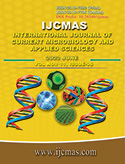


 National Academy of Agricultural Sciences (NAAS)
National Academy of Agricultural Sciences (NAAS)

|
PRINT ISSN : 2319-7692
Online ISSN : 2319-7706 Issues : 12 per year Publisher : Excellent Publishers Email : editorijcmas@gmail.com / submit@ijcmas.com Editor-in-chief: Dr.M.Prakash Index Copernicus ICV 2018: 95.39 NAAS RATING 2020: 5.38 |
Freeze-drying is a commonly used drying technique for sensitive biologicals, such as lactic acid bacteria (LAB). However, The choice of an appropriate drying medium is important, so as to increase the survival rates during dehydration itself and subsequent storage. The aim of the present study was to evaluate the protective effect of different agents (skim milk, yeast extract, sucrose, trehalose and glucose) on the survival of five potential probiotic LAB originated from traditional fermented products. The strain survival during freeze-drying and after 180 days of storage at 4°C was determined. After drying, the residual water contentswere between 3.17 and 8.59%. The results evidenced that LAB resistance to freeze drying was dependent on both microorganism and lyoprotective agent used. According the obtained rate immediately after freeze-drying, the used protective agents played an important role in preserving the strains viability apart from glucose. Lactobacillus plantarum S32 obtained the best survival withrate greater than 85% for 4 protective agentswith an optimum value for trehalose (94,01%). Pedioccocus acidilactici strains also had good survival with these same protectants. Refrigerated storage made it possible to achieve dried cultures with high stability and long shelf-life.
 |
 |
 |
 |
 |